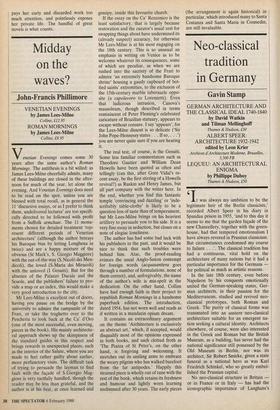Midday on the waves?
John-Francis Phillimore
Venetian Evenings comes some 30 years after the same author's Roman Mornings. The antithesis is a bit willed: as James Lees-Milne cheerfully admits, many of these buildings are closed in the after- noon for much of the year, let alone the evening. And Venetian Evenings does need to be read on the spot, unless you are blessed with total recall, as in general the 11 'discursive essays, or as I prefer to think them, undelivered lectures' are too specifi- cally directed to be followed with profit from a Suffolk armchair. The 11 monu- ments chosen for detailed treatment 'rep- resent different periods of Venetian architecture' (although the author betrays his Baroque bias by letting Longhena in twice) and are a happy mixture of the obvious (St Mark's, S. Giorgio Maggiore) with the out-of-the-way (S.Nicold dei Men- dicoli), the loved (S.Maria dei Miracoli) with the unloved (I Gesuiti). But for the absence of the Palazzo Ducale and the Scuole, and the publishers' failure to pro- vide a map or an index, this would make a very good introduction to the city.
Mr Lees-Milne is excellent out of doors, having you pause on the bridge by the university to admire the campanile of the Frari, or take the traghetto over to the Pescheria to look back at the Ca' d'Oro (one of the most successful, even moving, pieces in the book). His mainly architectu- ral approach shows up the skimpiness of the standard guides in this respect and brings rewards in unexpected places, such as the interior of the Salute, where you are made to feel rather guilty about earlier, more perfunctory visits. The difficult task of trying to persuade the layman to find fault with the fagade of S.Giorgio Mag- giore is very tactfully handled, though the reader may be less than grateful, and the author is at his best, at once learned and gossipy, inside this favourite church.
If the essay on the Ca' Rezzonico is the least satisfactory, that is largely because restoration and the curator's usual zest for swapping things about have undermined its (already suspect) accuracy, for otherwise Mr Lees-Milne is at his most engaging on the 18th century. This is so unusual an emphasis in writing on Venice as to be welcome whatever its consequences, some of which are peculiar, as when we are rushed into the sacristy of the Frari to admire 'an extremely handsome Baroque shrine' housing a gaudy cupboard of bot- tled saints' extremities, to the exclusion of the 15th-century marble tabernacle oppo- site (a capolavoro to Lorenzetti). Even that ludicrous intrusion, Canova's mausoleum, though described in terms reminiscent of Peter Fleming's celebrated caricature of Brazilian statuary, appears to escape without censure. I say 'appears', for the Lees-Milne dissent is so delicate (`Sir John Pope-Hennessy states . . If so, . . .') you are never quite sure if you are hearing it.
The real test, of course, is the Gesuiti. Some less familiar commentators such as Theodore Gautier and William Dean Howells have been quoted as often and tellingly (can this, after Gore Vidal's re- cent essay, be the first stirring of a Howells revival?) as Ruskin and Henry James, but all• part company with the writer here. In the end, whether you find this fantastic temple 'convincing and dazzling' or 'inde- scribably table-clothy' is likely to be a question less of taste than of temperament, but Mr Lees-Milne brings on his heaviest artillery to persuade you to his side. It is a very fine essay in seduction, but closes on a note of elegiac loneliness.
The author has had some bad luck with his publishers in the past, and it would be nice to think that such troubles were behind him. Alas, the proof-reading evinces the usual Anglo-Saxon contempt for foreign words (acquasantiera goes through a number of formulations, none of them correct), and, unforgivably, the name of the author's wife is mis-spelt in the dedication. On the other hand, Collins have had enough faith in their project to republish Roman Mornings in a handsome paperback edition. The introduction, dated 1954, has not worn well and reads as if written in a mandarin opium dream.
It contains an extraordinary argument on the theme 'Architecture is exclusively an abstract art,' which, if accepted, would disqualify most of the opinions expressed in both books, and such clotted froth as `The Piazza of St Peter's, on the other hand, is forgiving and welcoming. It stretches out its smiling arms to embrace the weary pilgrim who has walked barefoot from the far antipodes.' Happily this strained piece is wholly out of tune with the rest of the book, which retains its freshness and humour and lightly worn learning undimmed after 30 years. The early pieces (the arrangement is again historical) in particular, which introduced many to Santa Costanza and Santa Maria in Cosmedin, are still invaluable.


















































 Previous page
Previous page